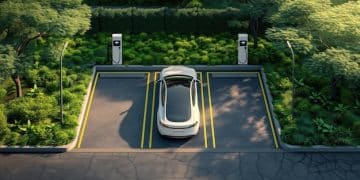Latest battery technology innovations in EVs

The latest battery technology innovations in EVs, including solid-state batteries and enhanced recycling methods, are pivotal for improving efficiency, sustainability, and safety in electric vehicles.
Latest battery technology innovations in EVs play a vital role in shaping the future of transportation. Have you considered how these advancements impact your driving experience? Let’s delve into the exciting developments that are enhancing electric vehicles.
Understanding the importance of battery technology in EVs
Battery technology is crucial for electric vehicles (EVs), as it directly affects their performance, range, and sustainability. Understanding how these technologies work helps us appreciate the evolution and future of transportation.
Why Battery Technology Matters
The development of advanced battery technologies can lead to significant improvements in EV efficiency and user experience. Innovations in materials and manufacturing techniques push the boundaries of what’s possible. As electric vehicles become more popular, the underlying battery technology must keep pace.
Key Factors in Battery Development
Several factors influence the progress of battery technology:
- Energy Density: Higher energy density allows EVs to travel longer distances without increasing battery size.
- Charging Speed: Fast charging capabilities enable quicker recharges, improving user convenience.
- Longevity: Durable batteries mean fewer replacements and improved sustainability.
- Environmental Impact: Sustainable materials and recycling methods reduce the ecological footprint of battery production.
New technologies such as solid-state batteries are emerging as potential game-changers. These batteries promise higher energy densities and improved safety compared to traditional lithium-ion. They can significantly enhance the performance of electric vehicles, allowing them greater range and faster charging times without compromising safety.
Additionally, battery technology is not just about performance; it is also essential for the overall infrastructure of electric mobility. As the number of EVs on the road increases, so does the demand for efficient charging stations equipped with advanced battery solutions. Companies are actively developing strategies to integrate innovative battery technologies into their charging networks.
Battery management systems also play a key role in optimizing the performance and lifespan of batteries. These systems monitor the health of the battery, ensuring it operates at optimal temperatures and charge levels. As technology advances, we can expect more sophisticated battery management systems that enhance the reliability of electric vehicles.
Recent advancements in battery materials
Recent advancements in battery materials are transforming the landscape of electric vehicles (EVs). These innovations not only improve performance but also enhance safety and sustainability. Understanding these materials can shed light on how they impact the future of electric mobility.
Breakthroughs in Battery Chemistry
Recent developments focus on improving battery chemistry. Innovations in materials like lithium-silicon and lithium-sulfur are promising. These materials can provide higher energy densities compared to traditional lithium-ion batteries.
Benefits of New Materials
Utilizing advanced materials brings several benefits:
- Increased Energy Density: New materials can store more energy, allowing EVs to drive further on a single charge.
- Improved Safety: Advanced materials help reduce risks like overheating and fires, enhancing overall vehicle safety.
- Cost-Efficiency: Innovations aim to reduce production costs, making EVs more affordable for consumers.
- Environmental Sustainability: New materials focus on sustainability, utilizing eco-friendly sources and improving recycling processes.
Additionally, researchers are exploring the use of graphene and nanomaterials, which provide unique advantages. Graphene, for example, offers excellent conductivity and strength, leading to lighter and more efficient batteries. Developing these materials further is crucial for the advancement of electric vehicles.
The shift toward using abundant and less toxic materials is also noteworthy. By focusing on environmentally friendly materials, manufacturers can create batteries that have a smaller ecological footprint. This is significant as the demand for sustainable EVs continues to rise among consumers and regulatory bodies alike.
Overall, the evolution of battery materials demonstrates the continuous innovation within the EV industry, paving the way for better performance and sustainability.
Impact of solid-state batteries on electric vehicles

The impact of solid-state batteries on electric vehicles (EVs) is significant, as they promise to revolutionize the way we think about battery technology. Solid-state batteries offer numerous advantages over traditional lithium-ion batteries, making them a hot topic in the automotive industry.
Enhanced Safety and Efficiency
One of the main benefits of solid-state batteries is their improved safety. Unlike liquid electrolytes, solid-state batteries use a solid electrolyte, reducing the risk of leakage and fire. This enhances safety for both the vehicles and their users.
Higher Energy Density
Solid-state batteries also provide a higher energy density. This means that they can store more energy in less space. With increased energy density, EVs can achieve greater ranges, alleviating concerns over charge levels and making electric vehicles more appealing to consumers.
- Longer Driving Range: Solid-state batteries can potentially double the range of current EVs on the market.
- Faster Charging Times: These batteries can offer quicker charging experiences, further improving user convenience.
- Durability: Solid-state batteries have a longer lifespan than traditional batteries, which can lower long-term ownership costs.
Additionally, manufacturers are excited about the possibility of reducing overall battery costs through economies of scale. As production ramps up, we may see solid-state batteries become more affordable and widely available. This shift could make electric vehicles even more appealing to the average consumer.
The transition to solid-state batteries is also crucial for the environment. With their longer lifespan and improved efficiency, solid-state technologies can help drive the shift toward more sustainable energy solutions. They can lead to decreased resource consumption and lower waste generation in the long run.
Overall, the rise of solid-state batteries represents a promising future for electric vehicles. As these technologies mature, we can expect to see exciting developments that will enhance our driving experiences while supporting a more sustainable planet.
How charging infrastructure is evolving with battery tech
Charging infrastructure is evolving alongside advancements in battery technology, significantly improving the electric vehicle (EV) experience. As battery tech becomes more efficient, so does the infrastructure that supports it, enabling faster and more convenient charging options.
Development of Fast Charging Stations
One major evolution is the rise of fast charging stations. These stations can significantly reduce charge times, making it easier for drivers to refuel their EVs during long trips. New technologies enable charging speeds that can replenish battery power in a fraction of the time it took just a few years ago.
Integration with Renewable Energy
Another important aspect of this evolution is the integration of renewable energy sources into charging stations. Many new charging points are designed to utilize solar and wind energy, which makes the charging process more sustainable and reduces reliance on fossil fuels. This shift is crucial for lowering the carbon footprint of electric vehicles.
- Smart Charging Technologies: New systems allow for better load management and can help avoid energy surges on the grid.
- Mobile Apps: Consumers can now locate the nearest charging stations, check availability, and even make reservations, enhancing user experience.
- Battery Storage Solutions: Many stations are using stationary batteries to store energy, ensuring a consistent power supply even during peak demand.
Moreover, the layout of charging stations is being optimized. As more EVs take to the road, charging station design is adapting to accommodate more vehicles efficiently. This includes developing multi-charging points that allow several cars to charge simultaneously.
Collaboration between governments, businesses, and technology providers is essential for expanding this infrastructure. Incentives for building more charging stations are becoming more common, ensuring a robust network is in place as the demand for electric vehicles continues to rise.
In summary, the evolution of charging infrastructure is a critical element of the shift toward electric mobility. Improved technologies and systems will enhance the convenience of owning an EV, making electric vehicles the preferred choice for many consumers.
Future trends in battery technology for sustainable EVs
Future trends in battery technology are crucial for creating sustainable electric vehicles (EVs). As more people switch to electric cars, advancements in battery technologies will shape the industry and impact our environment.
Emerging Battery Technologies
Several new technologies are being developed to make batteries more efficient and sustainable. For instance, sodium-ion batteries are gaining attention as a potential alternative to lithium-ion batteries. They are more abundant and less harmful to the environment, making them a promising choice for EVs.
Recycling and Second-Life Solutions
Another important trend is the focus on recycling and second-life applications for batteries. As batteries are used in electric vehicles, finding ways to recycle materials can significantly reduce waste. This practice not only conserves resources but also minimizes the environmental impact of battery production.
- Battery Reuse: After their life in EVs, batteries can be repurposed for energy storage in homes or businesses.
- Closed-Loop Recycling: This process involves reusing materials from spent batteries to create new cells, which can further reduce waste.
- Innovative Chemistries: Research in materials like magnesium-ion and aluminum-ion batteries aims to provide better alternatives that are earth-friendly.
In addition, advancements in smart battery management systems are set to enhance battery performance. These systems monitor battery health, ensuring optimal performance and safety while extending the lifespan of the batteries. Enhanced monitoring will lead to more efficient usage and greater reliability for electric vehicles.
Furthermore, partnerships between automakers and technology companies are expected to drive innovation in battery technology. Collaborations can lead to the development of new technologies that support both sustainability and efficiency in EV production.
As the automotive industry moves towards more sustainable practices, ongoing research and development in battery technology will play a vital role. It is essential for meeting the growing demand for electric vehicles while protecting our planet.
FAQ – Frequently Asked Questions about Battery Technology in Electric Vehicles
What are the benefits of solid-state batteries over traditional lithium-ion batteries?
Solid-state batteries offer higher energy density, improved safety, and longer lifespan, making them a superior choice for electric vehicles.
How is charging infrastructure adapting to advancements in battery technology?
Charging infrastructure is evolving with fast charging stations and integrating renewable energy sources to support the growing demand for electric vehicles.
Why is recycling battery materials important?
Recycling battery materials reduces waste, conserves resources, and minimizes the environmental impact of battery production and disposal.
What future trends can we expect in battery technology for EVs?
We can expect innovations like sodium-ion batteries, improved recycling methods, and smart battery management systems that enhance performance and sustainability.





